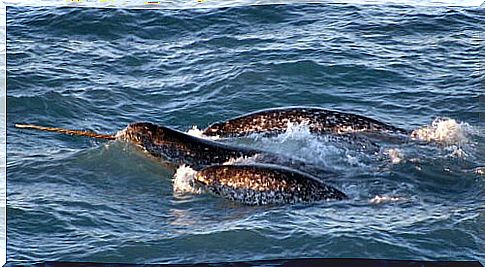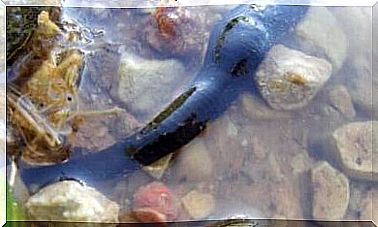Narwhal – The Wondrous Unicorn Of The Seas

Characteristics of the narwhal
The narwhal heard among the marine mammals to the so-called toothed whales and is very closely related to the beluga whales. It belongs to the whale family and is distinguished by a large horn on the tip of its head that is actually a tusk.
Males and females have slightly different bodies. Adult males weigh an average of 1,600 kg and females up to 1,000. Females are slightly smaller than males. They are about four meters long, while the male specimens can reach up to four and a half meters.
Another interesting feature is the fact that the narwhal changes color over the course of its life. Animals are born gray and dark spots appear, creating a unique pattern. The spots no longer form again when the animals reach the age of two. However, they grow over time. So it happens that the oldest specimens appear almost completely black: the spots have grown so far that they now cover the whole body.
The narwhal differs from other whales in that it does not have a dorsal fin. It also shares this characteristic with the belugas. Instead, it has a comb that is almost three feet long.
Its most noticeable feature is the enormous tusk that grows at the top of its head. It can be up to two meters long and weigh more than 10 kg. Only the males have the tusk, in the females it never develops.
Until recently, no one knew what the narwhal uses its tusk for. It was thought he would use it for guidance. Some scientists even went so far as to claim that it would break thin ice. Recent research showed that the narwhal uses its tusk for hunting. It stuns the fish by shaking it very quickly so that it can then eat it.
The behavior of the narwhal
The narwhal lives in small herds. Groups of two to nine animals form during the winter months, but in the summer they migrate south and form large herds of hundreds or thousands of narwhals.
It should be emphasized that narwhals are particularly noisy marine mammals. Many other whale species emit barely audible calls, but narwhals use constant sounds to communicate, and they also have a very broad vocabulary.
So they keep making clicking noises, just like dolphins. But whistles and other noises were also detected, which were interpreted as communication between narwhals. They can change these sounds, which is why scientists suspect that the animals use a complex language.
As for its diet, the narwhal gets food from the seabed. He submerges for up to 30 minutes and you know that he dives up to 800 meters deep. This means that, along with the sperm whale, it is one of the deepest diving mammals.
The habitat of the narwhals
In winter, the narwhal lives in the icy waters around the North Pole: in northern Canada, around Greenland and in the northern part of the Atlantic Ocean off Russia. In summer the animals migrate south and can be seen in some fjords and Canadian bays.
It is known that the species previously lived in warmer waters. However, through evolution, they moved to the coldest waters on our planet. They live in a very reduced living space. So we know that there aren’t that many specimens. They are an endangered species, even if they have few enemies. Only the Inuit people hunt narwhals.
The diet of the narwhal
The narwhal only feeds on fish and crustaceans, which is why it is known as a carnivore. It can feed on schools of fish near the surface of the water, but it often dives deep to eat the creatures that live on the ocean floor.
He has a particularly strong appetite when winter is just beginning. Then he ended his journey north to dwell in the icy waters again. When the waters freeze over, he eats very little. The animals have a very slow digestion. They can feed on the prey they ate for weeks or months.
The narwhal is another marine mammal that is threatened with extinction, but luckily it is a protected species. It is difficult to observe and really get to know him. However, it appears that the number of animals remains stable. It doesn’t have many natural enemies, but the worst threat to its survival is pollution.









